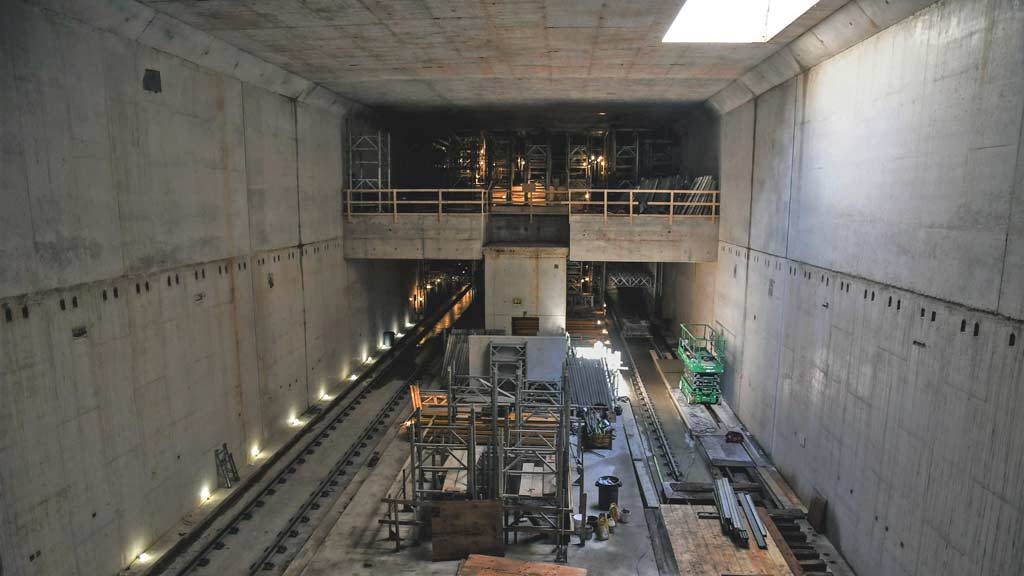A civil engineering research paper from the University of Toronto has found that tunnelling to construct rail transit creates 27 times the embodied greenhouse gases (GHG) per kilometre during the construction phase than building surface rail does.
It’s a finding that one of the three authors of the paper, Shoshanna Saxe, says should be relevant as the Ontario government prepares to issue a request for qualifications for the Ontario Line.
More and more jurisdictions are looking at the environmental costs of infrastructure projects as they evaluate the metrics factoring into project decision-making, said Saxe in an interview, and Ontario should too.
“California is doing it, the U.K., the E.U. and Canada is doing it as well, starting to think of the climate lens and the way infrastructure is funded,” she said. “We are seeing more attention in the building space than in the infrastructure space, but it is coming to infrastructure.”
The RFQ for the $10.9-billion Ontario Line, announced by Ontario Premier Doug Ford in April 2019 as a replacement for the former relief line subway concept, is expected to be issued this spring, a spokesperson for Infrastructure Ontario confirmed recently.
The project will have both surface and underground rails, with the latter required through the high-density neighbourhoods of downtown Toronto.
The Ontario Line is much needed, Saxe remarked, but she said she feared embodied GHG might not be given the hearing it should as the project goes to market.

“They don’t seem to be showing interest in considering environmental impact as an important metric,” she said of Ontario infrastructure projects. “It has not to date been a priority of the current government. It would be great if it was something that became part of the planning.”
Costing a project without considering environmental consequences is short-sighted, Saxe argued.
“We delude ourselves if we separate…financial impacts from the environmental and social costs,” she commented. “We just push those costs into other places. But we all pay for a polluted environment and a changing climate.”
The paper, titled Embodied Emissions in Rail Infrastructure: a Critical Literature Review and co-authored by Olubanjo Olugbenga and Nikolaos Kalyviotis with Saxe, was published in the journal Environmental Research Letters in November.
Metrolinx, the provincial transit agency, was among the funders of the research.
The authors identified 22 publications containing 57 case studies that touched on the topic of embodied GHG for different types of rail infrastructure construction.
The paper’s conclusion that “tunnelling has 27 (±5) times more embodied GHG per kilometre than at-grade construction” is not a great surprise, Saxe said.
“If it goes underground it takes a lot more material, it take a lot more construction, you have to dig the tunnel, you have to line and protect the tunnel, it takes a lot more material to construct the station, and because it is taking a lot more material and a lot more energy, there is a lot more in GHG emissions associated with the whole process,” she said, noting that “embodied” GHG includes such factors as the manufacture of construction materials, transporting them to the site and installing them.
Saxe stressed that discussions of GHG on project life cycles should by no means be limited to the strict construction phase that her team studied.
“This is just one part of the life cycle,” she said. “I am in no way saying because of this research we shouldn’t build subways underground, full stop.”
If tunnelling is the only option, her team’s analysis suggests project designers should thus spend more time thinking about the materials involved and energy needs, for example, to mitigate environmental harm.
“If you’re building in a place where you need to be underground and that is only place to build rail and the alternative is not to build it, you ask what other systems can be put in place to get the mode change we need so that people are going to be using rail,” she explained.
Follow the author on Twitter @DonWall_DCN.











Recent Comments
comments for this post are closed